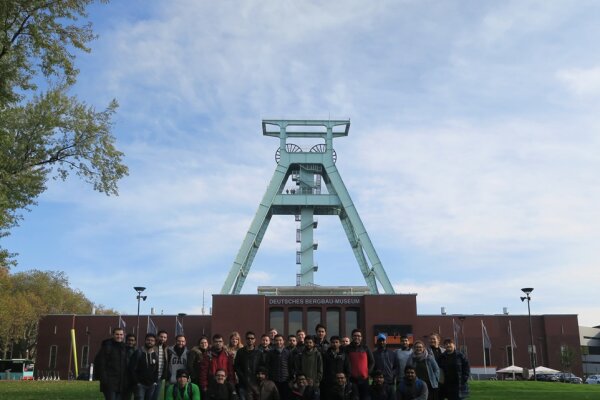2019-10-31

On Wednesday, the 30th of October the CompEng newcomers visited the German Mining Museum in Bochum (Deutsches Bergbau-Museum Bochum) which is one of the most visited museums in Germany with around 365,700 visitors per year.
The guided tour led us through a faithfully reconstructed show mine below the museum terrain giving us insights into the world of mining, 20m below the ground. In the network of about 2.5 km of tunnels we learned how coal was extracted; Two kinds of tunnel driving were shown: excavation with a full-face boring machine and with drilling and blasting. We saw numerous items of equipment with logistic and safety-related functions, such as the pneumatic hammer drill, in use since the beginning of the 20th century, which constitutes a major advance in the making of blast boreholes, which used to be laboriously drilled by hand. A highlight was the drilling jumbo which was a main equipment of mining technology at the end of the 1950s. Working with this drilling jumbo is less physically strenuous, as it only involves control levers. The noise exposure is high, however.
After the tour we took the elevator up to the headframe which is 71.4 m high and weighs 650 t. It was designed by the well-known industrial architects Fritz Schupp and Martin Kremmer and built in 1943/44 in its original location, above the main shaft of the Germania mining complex in Dortmund-Marten. In 1973 it arrived to Bochum. It is a well-known sight far beyond the borders of Bochum, and shapes the city’s silhouette. The view extends over the roofs of Bochum and far beyond the city limits.
Finally, we visited the permanent exhibition where we learned about the history of coal mining, treasures of mining-related art and the extraction of other raw materials such as copper, tin, or flint
We would like to thank our tour guides for the impressive tour.
A special shout out to the RUB Faculty of Civil and Environmental Engineering Sciences who helped to realize this event with their financial support.
Christina Rauch

On Wednesday, the 30th of October the CompEng newcomers visited the German Mining Museum in Bochum (Deutsches Bergbau-Museum Bochum) which is one of the most visited museums in Germany with around 365,700 visitors per year.
The guided tour led us through a faithfully reconstructed show mine below the museum terrain giving us insights into the world of mining, 20m below the ground. In the network of about 2.5 km of tunnels we learned how coal was extracted; Two kinds of tunnel driving were shown: excavation with a full-face boring machine and with drilling and blasting. We saw numerous items of equipment with logistic and safety-related functions, such as the pneumatic hammer drill, in use since the beginning of the 20th century, which constitutes a major advance in the making of blast boreholes, which used to be laboriously drilled by hand. A highlight was the drilling jumbo which was a main equipment of mining technology at the end of the 1950s. Working with this drilling jumbo is less physically strenuous, as it only involves control levers. The noise exposure is high, however.
After the tour we took the elevator up to the headframe which is 71.4 m high and weighs 650 t. It was designed by the well-known industrial architects Fritz Schupp and Martin Kremmer and built in 1943/44 in its original location, above the main shaft of the Germania mining complex in Dortmund-Marten. In 1973 it arrived to Bochum. It is a well-known sight far beyond the borders of Bochum, and shapes the city’s silhouette. The view extends over the roofs of Bochum and far beyond the city limits.
Finally, we visited the permanent exhibition where we learned about the history of coal mining, treasures of mining-related art and the extraction of other raw materials such as copper, tin, or flint
We would like to thank our tour guides for the impressive tour.
A special shout out to the RUB Faculty of Civil and Environmental Engineering Sciences who helped to realize this event with their financial support.
Christina Rauch